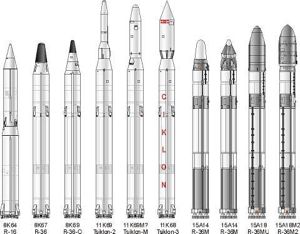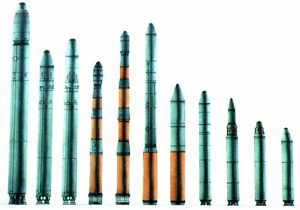
Home - Search - Browse - Alphabetic Index: 0- 1- 2- 3- 4- 5- 6- 7- 8- 9
A- B- C- D- E- F- G- H- I- J- K- L- M- N- O- P- Q- R- S- T- U- V- W- X- Y- Z
R-36M2
AKA: 15A18M2;RS-20V;Satan;SS-18 Mod.5 and 6;Voevoda. Status: Operational 1988. First Launch: 1986-03-23. Last Launch: 2004-12-22. Payload: 8,800 kg (19,400 lb). Thrust: 4,452.00 kN (1,000,849 lbf). Gross mass: 211,100 kg (465,300 lb). Height: 35.06 m (115.02 ft). Diameter: 3.00 m (9.80 ft). Span: 3.05 m (10.00 ft).
A tactical-technical specification was issued on July 1979 for a fourth generation heavy ICBM to replace the R-36MUTTKh and be capable of defeating future anticipated American anti-ballistic missile defences. The draft project was completed in June 1982 and featured uprated engines better resistant to nearby nuclear blasts. Decrees authorising development of the improved RD-263F booster engines was issued in December 1980. The draft project for the redesignated RD-274 engines was completed in December 1982. Development of the RD-274 was completed in May 1985 and the design passed to Yuzhnoye for production (some sources say that problems with turbine balance in the development of the RD-274 could not be resolved, and that the older RD-264 was installed in the production R-36M2).
A formal decree authorising development of the entire missile was issued on 9 August 1983. This included the RD-0255 upper stage engine and the four second-stage verniers. The missile would feature a new cold-launch gas generator designed by Zhukov at FTDT Soyuz. Flight trials of the missile with the 15F173 multiple-warhead bus began on 23 March 1986. The first launch was a tremendous failure. The cold-launch mortar fired, but the rest of the launch sequence failed. The missile exploded in the silo, blowing the 100 tonne silo lid far into the air and leaving only a huge crater at LC-101 Baikonur where the silo once was. The silo was beyond repair.
In May 1986 came one of many steps that seemed to indicate anticipation of the disintegration of the Soviet Union. It was decided the alternate 15F175 single-warhead bus, already designed by Yuzhnoye, would be built instead by a Russian enterprise.
Test flights with the Ukrainian 15F173 payload were completed in March 1988. The first test with the Russian 15F175 came a month later, and were completed in September 1989. On 11 August 1988 the R-36M2 and 15F173 warhead were accepted for military service, followed by the 15F175 warhead on 23 August 1990. The missile entered service at Dombarovskiy in December 1988, and at Uzhur and Derzhavinsk in 1990. A total of about 190 were built. Although Yuzhnoye developed life extension programmes to keep the missile in service for 15, 18, and 20 years, the missile itself was prohibited in in the START-2 arms reduction agreement. Replacement with the all-Russian Topol-M began in 1992 and by 1998 a total of only 58 silos were loaded with the R-36M2. The 150 missiles remaining had to be destroyed under treaty terms by 2007. Russia marketed them as the 'Dnepr' commercial launch vehicle.
The missile used a propellant utilisation system to minimise residuals. This gave it a total throw weight of 8.8 tonnes, matching that of the US Peacekeeper (an important issue driving its development). The multiple-warhead version could carry up to 20-36 independently-targeted warheads, although no more than ten were planned in service. They were arranged on a special frame in two 'circles of death'. The post-boost bus had four gimballed chambers, which fired continuously during the warhead dispensing process, making it extremely agile in flight.
The missile was equipped with a completely new set of countermeasures, considered more than adequate to counter America's Strategic Defense Initiative. The inertial guidance system was by Vladimir Sergeyev at NII-692/NPO Kharton. The systems were hardened for improved resistance to nuclear radiation or particle beams - the missile could be launched even after near-hits by enemy nuclear warheads. The entire rocket was encased in a heat shield against blasts or laser. The guidance system was equipped with sensors to detect gamma-rays and neutron fluxes and manoeuvre the missile during ascent away from nuclear explosions.
The development was completed on the guidance/countermeasures system for the single-warhead 15F173 dispenser in July 1987, and for the 15F175 multi-warhead dispenser in April 1988. Total Number Built 190.
Country: Ukraine. Engines: RD-0255. Spacecraft: MegSat, Microsat SSTL, Minisat SSTL, SaudiSat, UniSat, Ekol. Agency: Yangel.
 | R-36M1 model Credit: © Mark Wade |
 | Dnepr Dnepr cannister Credit: Ukrainian Space Agency |
 | R-36 Family |
 | ICBM-Derived LVs The range of launch vehicles derived from decommissioned ballistic missiles offered for sale by Russia after the cold war. Credit: © Mark Wade |
Back to top of page
Home - Search - Browse - Alphabetic Index: 0- 1- 2- 3- 4- 5- 6- 7- 8- 9
A- B- C- D- E- F- G- H- I- J- K- L- M- N- O- P- Q- R- S- T- U- V- W- X- Y- Z
© 1997-2019 Mark Wade - Contact
© / Conditions for Use